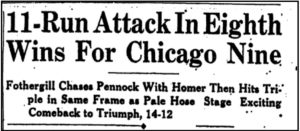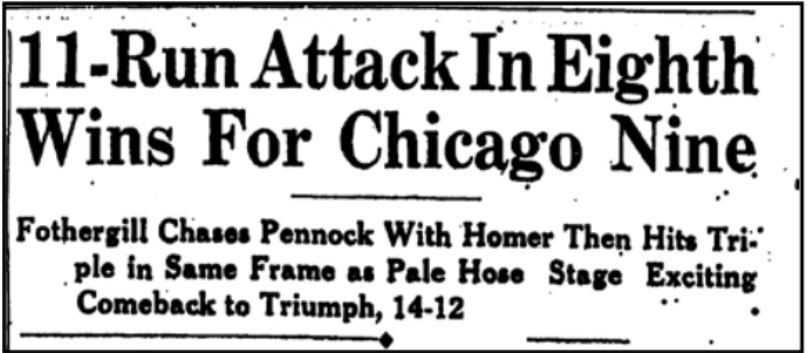July 28, 1931: Bob Fothergill leads White Sox in 11-run rally to beat Yankees
 In one of the greatest comebacks in major-league history, the Chicago White Sox “staged an eleven-run rally” in the eighth inning of a game against the New York Yankees, in front of the home crowd in the Bronx. The New York Times estimated that “twelve thousand fans, most of them Boys’ Club guests of the Yankees seated in the left-field stand,” witnessed the counterattack, which erased a nine-run New York advantage.1 Edward Burns of the Chicago Tribune wrote that the White Sox, “those undermanned wanderers,” scored 11 runs in the eighth inning “to nose out the powerful and affluent New York Yankees.”2 The Brooklyn Daily Eagle noted, “Fifteen Chicago batsmen came up and every one of them had a bat.”3
In one of the greatest comebacks in major-league history, the Chicago White Sox “staged an eleven-run rally” in the eighth inning of a game against the New York Yankees, in front of the home crowd in the Bronx. The New York Times estimated that “twelve thousand fans, most of them Boys’ Club guests of the Yankees seated in the left-field stand,” witnessed the counterattack, which erased a nine-run New York advantage.1 Edward Burns of the Chicago Tribune wrote that the White Sox, “those undermanned wanderers,” scored 11 runs in the eighth inning “to nose out the powerful and affluent New York Yankees.”2 The Brooklyn Daily Eagle noted, “Fifteen Chicago batsmen came up and every one of them had a bat.”3
By the end of July in the 1931 season, New York had been closing in on 60 wins, but they began a six-game series with Chicago stuck in third place in the American League. The Yankees were enjoying an extended homestand that saw them play only one game away from Yankee Stadium since the Fourth of July.4 They had played 18-8 baseball, leading up to this game on July 28, yet managed to gain only three games on the League-leading Philadelphia Athletics. Chicago, on the other hand, was in the midst of a 22-game road trip. The seventh-place White Sox had gone 6-10 coming into this contest.
For Chicago, sixth-year right-hander Tommy Thomas was given the start. He was looking for his third straight win, but he brought an ERA of 4.24 with him. New York countered with Herb Pennock, pitching in his 19th season. He had lost his last decision (on July 17), and his ERA stood at 4.29.
After Pennock easily retired the White Sox in order to start the game, the Yankees jumped on Thomas. Samuel Byrd and Joe Sewell each singled. With runners on the corners, Babe Ruth rolled a grounder to first baseman Lu Blue, who threw home to get Byrd. Lou Gehrig plated Sewell with a single. Thomas struck Ben Chapman with a pitch, loading the bases. Lyn Lary hit a fly ball to center, driving in Ruth, and New York had a 2-0 lead.
A one-out double by Bob Fothergill got things going for the White Sox in the second. John Kerr followed with a single to right, and Fothergill scored. An inning later, Chicago struck again. Thomas helped his own cause with a leadoff double to deep left field. Blue’s single resulted in an RBI and the game was tied.
Each pitcher settled down, working through the opposing team the second time through the order. Then, in the bottom of the fifth, Pennock drew a walk. An out later, Sewell reached on an error by shortstop Bill Cissell. Ruth again pulled a grounder to first for an out, advancing the runners. Thomas intentionally walked Gehrig. This backfired when Chapman singled to left, driving in two runs and sending Gehrig to third. Then, with right-handed batter Lary in the batter’s box, “Locomotive Lou Gehrig and Ben Chapman successfully put on a double steal,”5 with Gehrig swiping home and Chapman adding his 41st steal of the season.
Chicago manufactured a run in the sixth. Lew Fonseca singled and went to third on Fothergill’s second double of the game. Kerr hit a comebacker to Pennock, who threw to first for the out, but Fonseca scored.
The Yankees weren’t done scoring, though. In the sixth inning, “the trouble Thomas encountered was of his own making.”6 After retiring the first two New York batters, the White Sox pitcher seemed to lose control. He walked Pennock for the second time in the game. Byrd slammed a ground-rule double. Sewell doubled to right, plating both runners. Ruth singled to center, and Sewell scored. Gehrig singled and Chapman tripled to deep center, driving in two more. Chicago manager Donie Bush made a pitching change, probably a few batters too late. Right-hander Biggs Wehde came on in relief. Wehde had appeared in four games in 1930 (all in the same September week) and this was his seventh appearance of 1931. In his previous outing (July 26), he had pitched six innings against New York and had been touched for nine runs on 10 hits and four walks.7 Wehde walked Lary and gave up an RBI single to Bill Dickey.
Wehde walked Tony Lazzeri to start the bottom of the seventh. Pennock sacrificed Lazzeri to second and Byrd singled up the middle, making the score 12-3 in favor of the New Yorkers. Pennock and the Yankees were cruising.
Until the top of the eighth.
With one out, Chicago’s Carl Reynolds came through with his first hit of the game, a double. Fonseca singled for a run batted in, and then Fothergill drove a homer into the left-field stands. Kerr singled and Pennock’s afternoon was finished. Red Ruffing became the new Yankees hurler. Cissell greeted him with a single. Frank Grube also singled, with Kerr scoring. Smead Jolley batted for Wehde and doubled, scoring Cissell and sending Grube to third. Pat Caraway ran for Jolley. Blue launched a ball to Lazzeri at second that hit him in the chest and rolled across the foul line. Blue was credited with a triple and two runs batted in.
Ruffing was lifted for Lefty Gomez. Irv Jeffries, another pinch-hitter, hit a fly to right, and Blue scored. Gomez couldn’t keep the bases empty, though. Reynolds doubled, his second two-bagger of the inning, which tied a record for most doubles in an inning. Fonseca drove him home with a single, and this brought up Fothergill for his second at-bat of the inning. He “poked a fly to right which became a triple when Ruth tried for a shoestring catch and failed to stop the ball.”8 Fonseca had crossed the plate with the go-ahead (13th) run for Chicago. According to the Chicago Tribune, “It scarcely could be figured that Fothergill, with two doubles and a homer already in his bag, was due, but plump Robert delivered a triple.”9
Jim Weaver became the fourth New York pitcher of the inning, replacing Gomez, and gave up an RBI single to Kerr. Fothergill’s run made it 14-12 in favor of the visitors. Cissell grounded out, but Chicago had sent 15 batters to the plate, scoring 11 tallies.
Reynolds, Fonseca, Fothergill, and Kerr each collected two hits in the big inning. Chicago did not discriminate, blasting Pennock, Ruffing, and Gomez with equal power, “as their rally roared and rumbled.”10 The White Sox had sent the three future Hall of Famers to the showers in the same frame.
Vic Frazier pitched the eighth and ninth innings for the White Sox, but the Yankees were obviously deflated and went hitless. The final score remained Chicago 14, New York 12. The top seven men in New York’s order garnered all of their 13 hits, but it was not enough. Ten different Chicago batters had contributed to their 20-hit attack. Fothergill led the way in a 4-for-5 effort with 11 total bases, and his home run and triple in the eighth were the key blows. Blue, Fothergill, and Kerr each had three runs batted in.
Amazingly, Wehde picked up the victory, earning notice in the next day’s papers with, “Wilbur Wehde may not remain long in the majors, but he can tell his grandchildren how his name went down as the winning pitcher the day the White Sox scored 11 runs in one inning against the Yanks.”11 This was somewhat prophetic, as Wehde appeared in only one more major-league game. That contest has a twist: Wehde came on in the eighth inning five days later, on August 3 against Detroit with two outs and runners at first and second. After a pitch to the batter, the runner at second was caught stealing for the final out of the inning. The White Sox were behind, so Detroit didn’t bat in the ninth. Wehde’s line was one-third of an inning pitched but he was not credited with facing a batter. Wehde’s career in the majors consisted of 12 appearances (all in relief), 22⅓ innings pitched and a 1-0 record.
The New York Times told its readers that the White Sox “fell short by three runs of equaling the modern record for runs scored in an inning.”12 On September 6, 1883, the Chicago White Stockings exploded for 18 runs against the Detroit Wolverines. The modern record (since 1900) belonged to the 1920 Yankees (who scored 14 runs in the fifth frame against the Washington Senators on July 6, 1920) and the 1922 Chicago Cubs (who scored 14 runs in the fourth inning against the Philadelphia Phillies on August 25, 1922).
Sources
In addition to the sources mentioned in the Notes, the author consulted baseball-reference.com, retrosheet.org, and sabr.org.
Notes
1 William E. Brandt, “11 White Sox Runs in 8th Beat Yanks,” New York Times, July 29, 1931: 25. Neither baseball-reference.com nor retrosheet.org lists the official attendance.
2 Edward Burns, “Sox’ 11 Run Rally in 8th Beats Yanks, 14-12,” Chicago Tribune, July 29, 1931: 15.
3 “1-Frame Orgy of Hits Just Buries Yanks,” Brooklyn Daily Eagle, July 29, 1931: 20.
4 The Yankees traveled to Washington on July 12 for a single game against the Senators.
5 Brooklyn Daily Eagle.
6 Burns.
7 Wehde had entered the July 26 game as a reliever, after starter Caraway had allowed 13 runs (10 earned), so Wehde did not get a decision.
8 Brandt.
9 Burns.
10 Brandt.
11 Burns.
12 Brandt.
Additional Stats
Chicago White Sox 14
New York Yankees 12
Yankee Stadium
New York, NY
Box Score + PBP:
Corrections? Additions?
If you can help us improve this game story, contact us.


